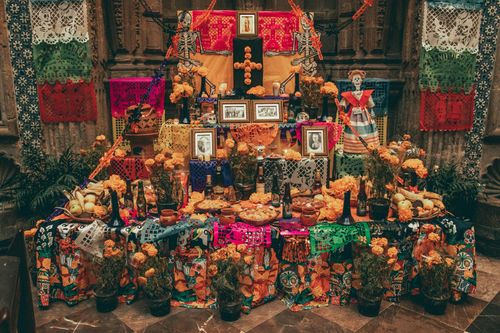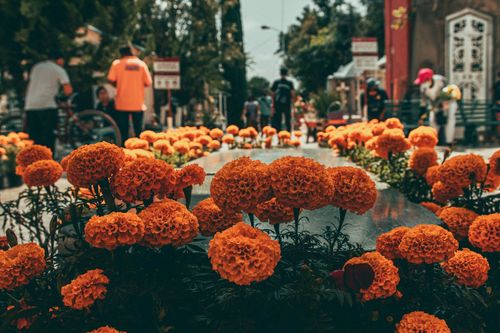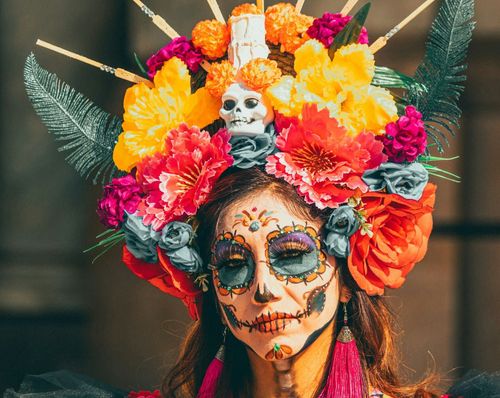The Day of the Dead, or Día de los Muertos in Spanish, is a curious Mexican celebration. Families gather to honor the departed souls of their loved ones. This tradition is very thoughtful, yet a bit scary, some may say. Mexicans wear skeleton costumes and gather at graves, sometimes in a quiet way, sometimes celebrating as though they’re at a family reunion.
Is the Day of the Dead the Mexican Halloween? Read more about this unique Mexican festival in this article.
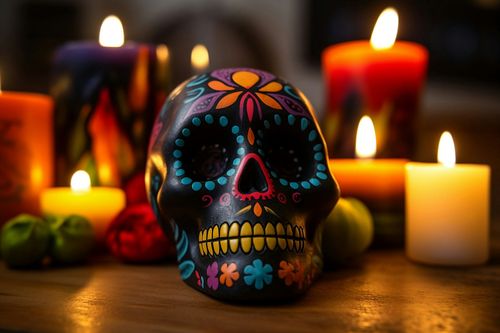
Photo by Brian Wegman 🎃 on Unsplash
What Is the Day of the Dead or Día de los Muertos?
Day of the Dead, or Día de los Muertos in Spanish, is a holiday celebrated mainly in Mexico, with some recognition in Spain. It honors those loved ones who have passed away in a way that feels joyful, not scary like Halloween. This holiday runs from October 31 until November 2, mixing old traditions and Catholic beliefs.
They build altars, known as ofrendas, with flowers, candles, photos, and food the deceased enjoyed in life. Families visit graves, clean them up, and decorate them with flowers. There are also parades with people dressed as skeletons.
While, in Spain, families go to cemeteries, pray, and share quiet moments. Both countries remember loved ones, each in its own way.
The History Behind The Day Of The Dead
The Day of the Dead, it’s a curious mix of Indigenous and Spanish traditions.
The Day of the Dead has its roots in Mesoamerican beliefs, mainly among the Aztecs. For these ancient cultures, death was part of an ongoing journey. While they believed the dead lived on in a spirit world led by the god Mictlantecuhtli. Each year, the Aztecs held month-long ceremonies for their ancestors.
Then, when the Spanish arrived in the 16th century, they brought their Catholic traditions, such as All Saints’ Day and All Souls’ Day in early November. As time passed, Aztec Indigenous customs mixed with Catholicism, creating the modern Day of the Dead.
Key Traditions of Día de los Muertos in Mexico City
In Mexico City, this day has all sorts of traditions that mix together to remember loved ones who have passed away. Here’s a look at some key traditions of this holiday:
- Ofrendas: are altars at home or in cemeteries. They pile up photos, candles, marigolds, and even sugar skulls. It’s a way to welcome back spirits.
- Sugar Skulls (Calaveras de azúcar): Sugary skulls made of sugar and decorated with icing meaning the sweet, fragile nature of life. They often come with names on them and are more fun than scary.
- La Catrina: The most iconic skeleton symbol, reminding everyone that life and death in contrast are just two sides of the same coin.
- Marigolds (Cempasúchil): Known as the “flower of the dead,” marigolds’ bright colors supposedly help spirits find their way home.
- Festive Parades: Mexico City hosts grand parades like the Día de los Muertos Parade, which light up the city with floats, dancers, and musicians, while everyone has fun around in skeleton costumes.
- Face Painting: Folks paint their faces to look like skeletons, often inspired by La Catrina. It’s a colorful, fun tradition, showing how life and death are mixed together.
- Pan de Muerto: A sweet bread shaped round with bone-like decorations and sugar on top with flavors like orange zest or anise. It’s a traditional family treat during Día de los Muertos, enjoyed together, with some of it placed on the altar.
- Tamales: A culinary icon in Mexican food, especially during this holiday. Tamales are made from corn dough and wrapped in leaves. They can be filled with meats or cheeses and are often prepared together as a family.
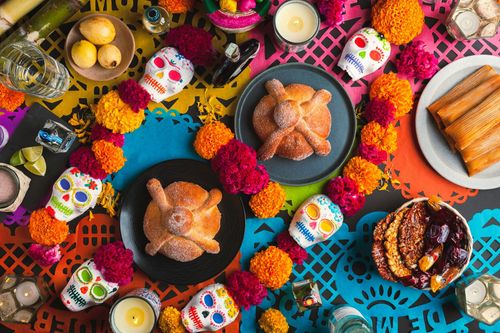
Photo by Gerardo Covarrubias on Unsplash
How Spain Celebrates Día de los Difuntos
In Spain, Día de los Difuntos (Day of the Deceased) takes place on November 2, right after Día de Todos los Santos (All Saints’ Day) on November 1. Spain takes a more subdued path focusing on prayer and reflection, honoring those who have passed on, rather than celebrating. Spanish traditions during the Day of the Dead include:
Cemetery Visits and Grave Decorations
Spaniards visit cemeteries to clean, tend, and decorate graves with fresh flowers. Especially chrysanthemums, which are considered the star for remembrance and mourning. These outings feel more like quiet moments, where families gather to honor their loved ones.
Attending Mass and Prayers for the Dead
Families attend Catholic Mass to pray for the departed souls in cemeteries or chapels. Unlike Mexico’s Day Of The Dead fun parades, the Spanish center around soft prayers and spiritual meaning.
Traditional Sweets and Pastries
Spanish bakeries whip up tasty treats such as huesos de santo (Saint’s Bones) made from marzipan and filled with sweet egg yolk. They also have buñuelos de viento (fried dough balls). These goodies are part of the Spanish Day Of The Dead holiday, savored by families as they reminisce about their loved ones.
Day of the Dead in The Philippines
In the Philippines, a similar but culturally distinct celebration called Undas or Araw ng mga Patay (Day of the Dead) also takes place on November 1 and 2. Like in Spain, Undas has solemn Catholic roots but also includes unique Filipino traditions.
Families visit cemeteries to clean graves and leave flowers and candles. They spend time together, eat, and pray for their loved ones. They light candles both at home and in cemeteries to honor those who passed. Food like rice cakes and bibingka is shared or left at graves as offerings.
Day of the Dead Mexican Symbols
The Day of the Dead, or Día de los Muertos in Spanish, is about love, memory, and life after death. It’s a mix of ancient customs and new Catholic beliefs. Its most important symbols are:
- Calaveras (Skulls): Skulls, called calaveras, are popular during this celebration. They’re meant to remind folks not to be scared about death; as it’s just a part of life.
- La Catrina: La Catrina is a skeleton lady dressed in stylish clothes with an elegant hat. This symbol of the Day of the Dead started with José Guadalupe Posada and became famous thanks to painter Diego Rivera. La Catrina skeleton shows that death treats everyone the same, no matter how wealthy you are in life.
- Marigolds (Cempasúchil): Marigolds, or cempasúchil, are the “dead flowers.” Their bright orange and yellow colors help spirits find their way back to the living. They’re often scattered on altars and graves to make them look colorful and inviting.
- Ofrendas (Altars): Ofrendas are probably the heart of the celebration. These altars can be found everywhere, decorated with pictures, candles, food, and other things that the deceased liked. Each one has to have a purpose, from candles guiding spirits to salt for cleansing.
- Candles: Candles light up altars and graves, and guide the spirits home. Each one stands for a memory of someone who’s passed. Sometimes, people arrange candles in a cross shape to keep spirits safe on their journey.
- Butterflies: Monarch butterflies come to Mexico in the fall, and many think they carry the souls of the dead back to visit. Their arrival surprisingly aligns with Día de los Muertos, making them extra special!
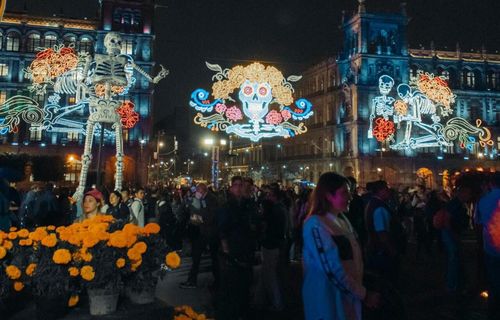
Photo by Fernando Paleta
Día de los Muertos in Popular Culture
Día de los Muertos is now a popular celebration all over the world, thanks to movies and parades. For example, Disney-Pixar’s Coco introduced many to this holiday. It’s about a kid named Miguel who goes to the Land of the Dead. There are colorful visuals, marigold paths, and fun family traditions. Think of it as a lovely way to remember ancestors, not just as a “Mexican Halloween.”
The parade in Mexico City, inspired by Spectre, was first held in 2016. It turned into a huge tourist attraction with floats, skeleton costumes, and face paint, bringing people together to celebrate.
Social media helped spread the Día de los Muertos phenomenon too. Also, artists and designers love using La Catrina and other self-invented colorful skeletons. Museums hold workshops to teach about the holiday’s roots.
Stay Connected in Mexico with Yoho Mobile
Planning to celebrate The Day of the Dead? How will you keep track of local events or stay in touch with family?
With mobile data, you’re always connected and informed. Yoho Mobile eSIM offers you reliable internet access no matter where the celebrations take you. It’s the easiest and fastest solution—perfect for travelers who want to stay online while enjoying the festivities.
Give roaming charges and old SIM cards a rain check with a Yoho Mobile eSIM!
🎁 Exclusive Offer for Our Readers!Get your first order with Yoho Mobile FREE by using the code YOHOREADERSAVEStay connected easily during your trip to Mexico with our eSIM. Don’t miss out—this offer ends soon! |

